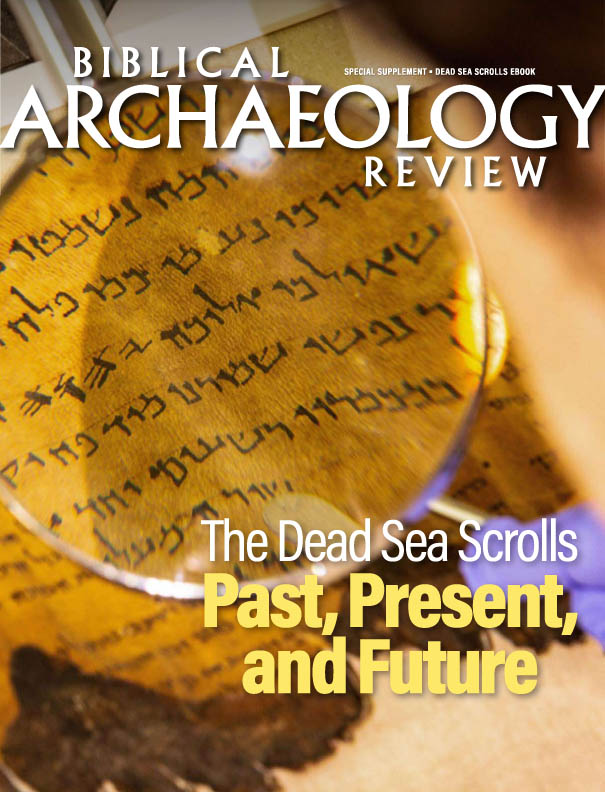
Joe Uziel. Image courtesy the Israel Antiquities Authority.
Joe Uziel, who heads the Dead Sea Scrolls Unit at the Israel Antiquities Authority (IAA), spent many years excavating the City of David and the Western Wall Tunnels. Biblical Archaeology Review Assistant Editor Nathan Steinmeyer recently sat down with Uziel to discuss the IAA’s critical role in the conservation, curation, documentation, and research of the Dead Sea Scrolls. The conversation has been edited and modified for clarity and readability. To read the full interview and learn more about ongoing efforts to preserve the scrolls, download the free eBook, The Dead Sea Scrolls: Past, Present, and Future.
(1) 2 3 4 5
When did conservation of the Dead Sea Scrolls become a priority?
UZIEL: In 1947, the first scrolls were discovered in Qumran. Today, we have some 1,000 manuscripts made up of about 25,000 fragments. Over the last 70 years numerous treatments were carried out on the scrolls, always with the best intentions, to unroll them, improve legibility, and piece them together. The most noteworthy treatments were the extensive use of pressure sensitive tape by the first scholars, in the 1950s, to join fragments and the occasional use of castor oil and other surface treatments to conserve the scrolls. These practices, together with the employment of glass plates to encase the fragments, proved detrimental to the scrolls. Additionally, the use of British Museum Leather Dressing in the early 1960s and acrylic glue in the 1970s caused further damage to the fragments.
1 (2) 3 4 5
How did the IAA get involved?
UZIEL: The preservation of the scrolls was one of the main concerns by the time the IAA was established in 1991. That led to the establishment of a designated conservation laboratory to treat and maintain the scrolls, attempting to prevent further deterioration. Work protocols were drawn up, and a climate-controlled environment was built to house and care for the scrolls and ensure stable temperature and humidity levels and minimal light exposure. In 2010, the Dead Sea Scrolls Unit was established, expanding the IAA’s approach to the scrolls, including conservation, curation, documentation, research, and outreach.
1 2 (3) 4 5
What methods does the IAA use to ensure the preservation of the scrolls?
UZIEL: After consultations with experts, we established a unique monitoring system based on multispectral imaging technology. The system, developed by MegaVision Ltd., uses different wavelengths and exposures to provide objective and sound documentation of each and every fragment. For the system to monitor any changes in the physical state of the scrolls, we need to create standard parameters that do not change. In this manner, periodically imaging a fragment under the same conditions and comparing those images through advanced computational analysis allow us to detect any change. The use of different spectral bands and angles of light emphasize different features. Some are very good at bringing out the carbon ink used to write the scrolls. They bring out the writing in areas that have been blackened due to the deterioration of the scrolls. Others give you the topography of the scroll, because a scroll isn’t nice and flat. It has waviness. These are important bits of information that can monitor changes in the physical state of the scroll.
1 2 3 (4) 5
How does your team approach a new scroll?
UZIEL: When a fragment is brought to the unit, it is immediately registered in our database, followed by an assessment of its condition. We then make decisions about conservation methods and procedures to make the scroll readable. Our primary concern is conservation. When possible, crumpled fragments may be slowly unfolded and separated, while documenting the entire process. This is a tedious process that can last for months. The fragments are imaged in the multispectral system both before and after they have undergone conservation and have been placed in their estimated position. At the same time, our researchers work on the decipherment of the text. They prepare the transcription, analyze the paleography, language, and content, and study the finds in their historical and literary context. The final product is the scientific publication, which presents the results of our research.
1 2 3 4 (5)
What happens after a scroll has been conserved and published?
UZIEL: We then store the document under strict climatic conditions, periodically monitoring its condition both through visual inspection and imaging technology. The images are also made available to both scholars and the public through the Leon Levy Dead Sea Scrolls Digital Library. The library enables access to the images, which are often more useful to study than the actual fragments themselves. This also helps with the conservation of the scrolls, since they are removed from storage far less often. The continued development of digital tools will certainly contribute to future research on the Dead Sea Scrolls.

Read more in Bible History Daily:
The post 5 Questions: Preserving the Dead Sea Scrolls appeared first on Biblical Archaeology Society.


0 Commentaires